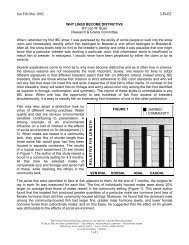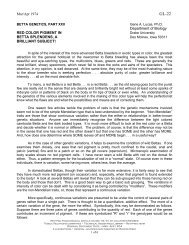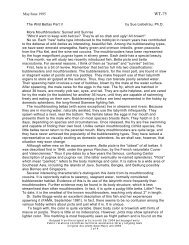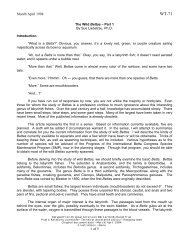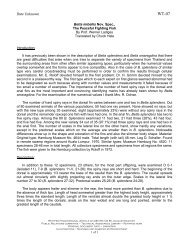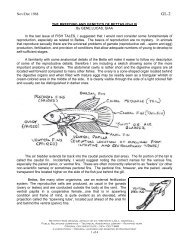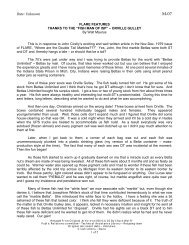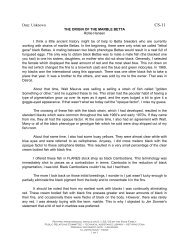GL-04: Betta Genetics Part IV
GL-04: Betta Genetics Part IV
GL-04: Betta Genetics Part IV
- No tags were found...
You also want an ePaper? Increase the reach of your titles
YUMPU automatically turns print PDFs into web optimized ePapers that Google loves.
Mar/Apr. 1969<strong>GL</strong>-4BETTA GENETICS PART <strong>IV</strong>by GENE LUCAS, GIAATHE MUTATIONSthe last century).In our last installment, I said I would begin to describe the variousmutations that exist in domestic <strong>Betta</strong>s. Like the many fancy variants ofgoldfish, many of the various forms of <strong>Betta</strong>s must have occurred andprobably were preserved in domesticated stocks before we had anysuitable record. <strong>Betta</strong>s are known to have been domesticated for manyyears before credible records (which only date back to the first half of<strong>Part</strong> of the uncertainty lies in the fact that it was a common practice in the last century (and wellinto this) to make much over merely describing and naming new types of organisms. Lacking some ofthe more sophisticated methods of establishing relationships that are available today, many weredescribed and named which actually should not have been.Those interested in the history of <strong>Betta</strong>s, and the aquarium hobby in general, would enjoy leafingthrough 30 and 40 year old copies of some of the commercial publications. I recently chanced upon anumber of old copies of “Aquatic Life.” The ones I obtained cover theperiod from around 1924 to 1940. What I found especially interesting wasthe discussions raging over the appearance of several <strong>Betta</strong> forms.It appears that the most reliable reports regarding imports of <strong>Betta</strong>sare attributing the “first” <strong>Betta</strong>s to two people. Mr. Frank Locke, of SanFrancisco and Dr. Hugh Smith of the U.S. National Museum. The importscame in 1927. Prior to that only wild <strong>Betta</strong> splendens were known in theUnited States. Locke’s and Smith’s fish, however, were “veil-tailed” andCambodian.” In October of 1927 a translated German article in AquaticLife by a Hermann Meinken described “astonishing new veiltailed fighting fish” in Germany.An article by the same Meinken in February 1930, describes new colors: “sea green, blue green,cobalt blue, cornflower blue…multicolor…all the colors of the rainbow.” Ads for the red Veiltail <strong>Betta</strong>rubra appeared in the early 30’s. The last indicates the problem. Attempts were made to name each ofthe many color types as a new species. <strong>Betta</strong> viridens, <strong>Betta</strong> cyana, <strong>Betta</strong> rubra, <strong>Betta</strong> cambodia, var.longicauda, and other such names attempted to establish individual identity for these different andbeautiful fish. The only evidence of their origins is “from adealer in Singapore”, “from Bangkok”, or similar statements.Obviously they must have come into existence before findingtheir way into a dealer’s hands, (though they might have beendeveloped by dealers who were also breeders).Though information regarding one species, nowconsidered to be definitely a different species (<strong>Betta</strong> pugnax)is scarce, there were suggestions concerning the possibleorigins of at least one color,red. It was said that red was obtained by crossing redcoloredB. pugnax with B. splendens. While this procedurewas successful in the case of the Platy-sword crosses, I doubt if the <strong>Betta</strong> suggestion could be true,Retyped from original article on 01/08/00 by Lisa L. IngersollPublic Relations committee ~ Technical Assistance Library ~ Retyping teamOriginal document date ~ Mar – Apr1969Illustrations ~ Original, scanned and inserted by Rhonni Kiest1 of 3
Mar/Apr. 1969<strong>GL</strong>-4since our limited knowledge of the real B. pugnax indicates that it is a mouthbreeder and crossesbetween species having different modes of reproduction are highly unlikely.The fact that B. splendens was still being referred to as B. pugnax as recently as 1961 is enoughto convince me that an early breeder might have had a red mutant, and, considering it different,crossed it with a wild B. splendens. Then after developing more reds, believing that he had “produced”a new <strong>Betta</strong> type from this cross. Actually he had, but not from an interspecific cross as he thought (myopinion). We now recognize the difficulty of hybridizing unlike types whereas in those days“hybridizing” was thought to be an easy, common practice. Hybridizing domestic animals is, of course,mostly intra-specific (though perhaps interbreed) crossing, which (forgive me) is a horse of anothercolor!So it appears quite logical that there already existed “strains” of various colors and fin types, but allwere variations of B. splendens. Dr. George S. Meyers, a well known systematic ichthyologist, wasquick to challenge early nomenclature. In Aquatic Life, February 1929, he pointed out that it wasalmost certain that cambodia, rubra and the long finned variation were merely new types of B.splendens. Exotic names die hard, though, as evidenced by our firmly entrenched use of the name“cambodia” for the albinistic form of our <strong>Betta</strong>s. (Without red or pink eyes they just couldn’t hack it asalbinos!)While the presence of pigment in the eyes makes things terribly confusing for many, the factremains that the cambodia mutant is essentially an albino. I say this, using the general definition ofinability to form integumentary melanin in significantamounts as my “guide.” Fish hobbyists quite readilyaccept the presence of red, yellow or guanin coloration in“albino” fish… so long as they have those magical red eyepupils. It doesn’t require much imagination to believe thatthe formation of the eye pigment (not in the iris but in thepigmented inner layers) might occur before a pigmentforming system in the embryo breaks down. Somevariation of this concept, involving formation of pigment atdifferent times, then stability in the differential tissue couldaccount for the apparent peculiar expression of “albino.”Still, this albinistic type is not the same as what most would call albino. Tantalizing reportsperiodically make the rounds of a “real” albino (meaning one that has red eyes! No matter what othercolors!) Goodrich and Mercer (1934) reported that the cambodia type was inherited as recessive andused the symbol “c” as its designation. The findings were confirmed by Domantay (1935), Umrath(1939), Eberhardt (1941) Wallbrun (1958) and others. My own considerable data regarding thismutation also confirm the mode of inheritance. Umrath used the symbol “c” to designate albino andapparently differentiated between cambodia and albino. Schreitmuller (1927) reported a “total” albinowith “red, bloodshot” eyes. The battle was already joined.As I suggested last time, cambodia is a simple mutant, a very easy one to study and work with.The normal gene for black pigment allows the fish to develop the appropriate number of pigment cellscontaining a normal amount of black pigment. The abnormal gene malfunctions so that either aninsufficient number of cells develop or they are unable to develop sufficient pigment. The abnormalityis inherited as a simple Mendelian recessive, requiring the gene from both parents to have its effect. Ifeven one normal gene is present the fish will have normal amounts of black color.Retyped from original article on 01/08/00 by Lisa L. IngersollPublic Relations committee ~ Technical Assistance Library ~ Retyping teamOriginal document date ~ Mar – Apr1969Illustrations ~ Original, scanned and inserted by Rhonni Kiest2 of 3
Mar/Apr. 1969<strong>GL</strong>-4It is quite obvious that cambodias come in all kinds of color variations. The reasons for thesevariations will be discussed as I go through the list. Just remember that, as far as cambodia isconcerned, it is either the presence of sufficient black pigment or the absence which must beconsidered. The other color effects are independent and must be considered as such.I should suggest that there may be a slight effect on red also but this has not been worked out byscientific analysis so very little can be said of this possible side effect. For all practical purposes abreeder can accurately predict the expected progeny types from mating involving the cambodianmutation. I will not review these here as I used them as an example in the last installment. Check backinto that if additional information is desired.I might add that I would welcome questions regarding things that are mentioned in the series. Feelfree to comment, etc. as I may be skimming over things that are far more clear to me than they are tothe reader. I can either respond directly, via the series or in FISH TALES, whichever seems mostappropriate.References:Domantay, J.S., 1935. The culture of the Siamese Fighting Fish, Phillipine Jour. Sci., Manila, 58, No. 4,521-528.Eberhardt, K. 1941. Die Vererbung der Farben bei <strong>Betta</strong> splendens Regan I. Z. i. A. V. 79:363-373.Goodrich, H.B., and R.N. Mercer. <strong>Genetics</strong> and Colors of the Siamese Fighting Fish. Science, 79:318-319.Schreitmuller, Wil., 1927. Ein Total Albino von <strong>Betta</strong> splendens Regan Siamesisher Kampffisch.Blatter f. Aquarian-u Terrerienk., 38, No. 12:237-328.Umrath, Karl, 1939. Uber die Vererbung der Farben und des Geschlechts bei Schleirkampffisch, <strong>Betta</strong>splendens. Z.i.A.V. 77:450-454.Wallbrun, Henry M. 1958. <strong>Genetics</strong> of the Siamese Fighting Fish, <strong>Betta</strong> splendens. <strong>Genetics</strong> 43: 289-298.Retyped from original article on 01/08/00 by Lisa L. IngersollPublic Relations committee ~ Technical Assistance Library ~ Retyping teamOriginal document date ~ Mar – Apr1969Illustrations ~ Original, scanned and inserted by Rhonni Kiest3 of 3




